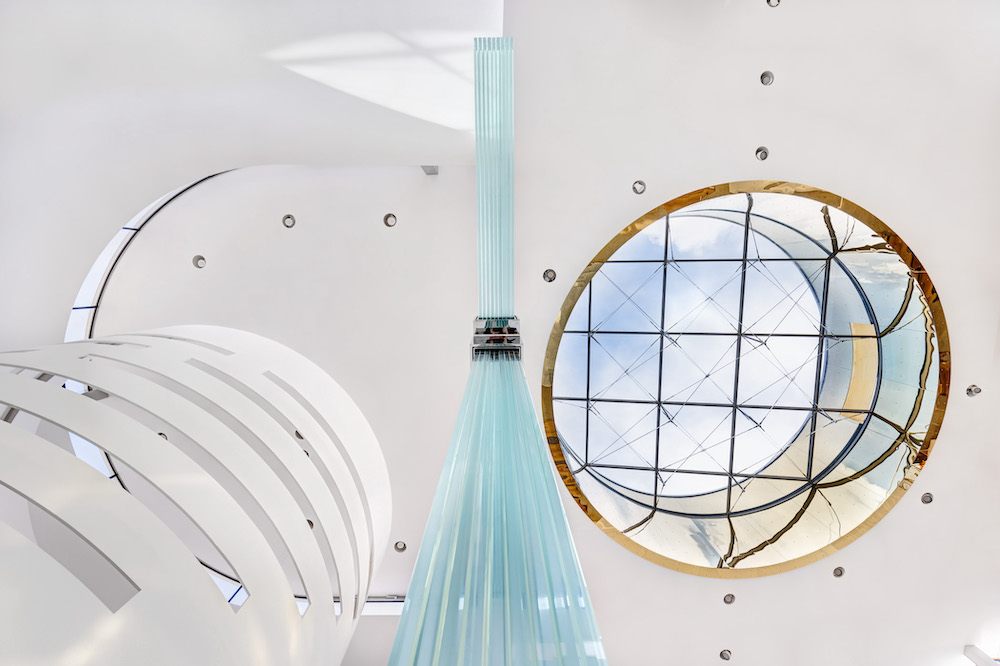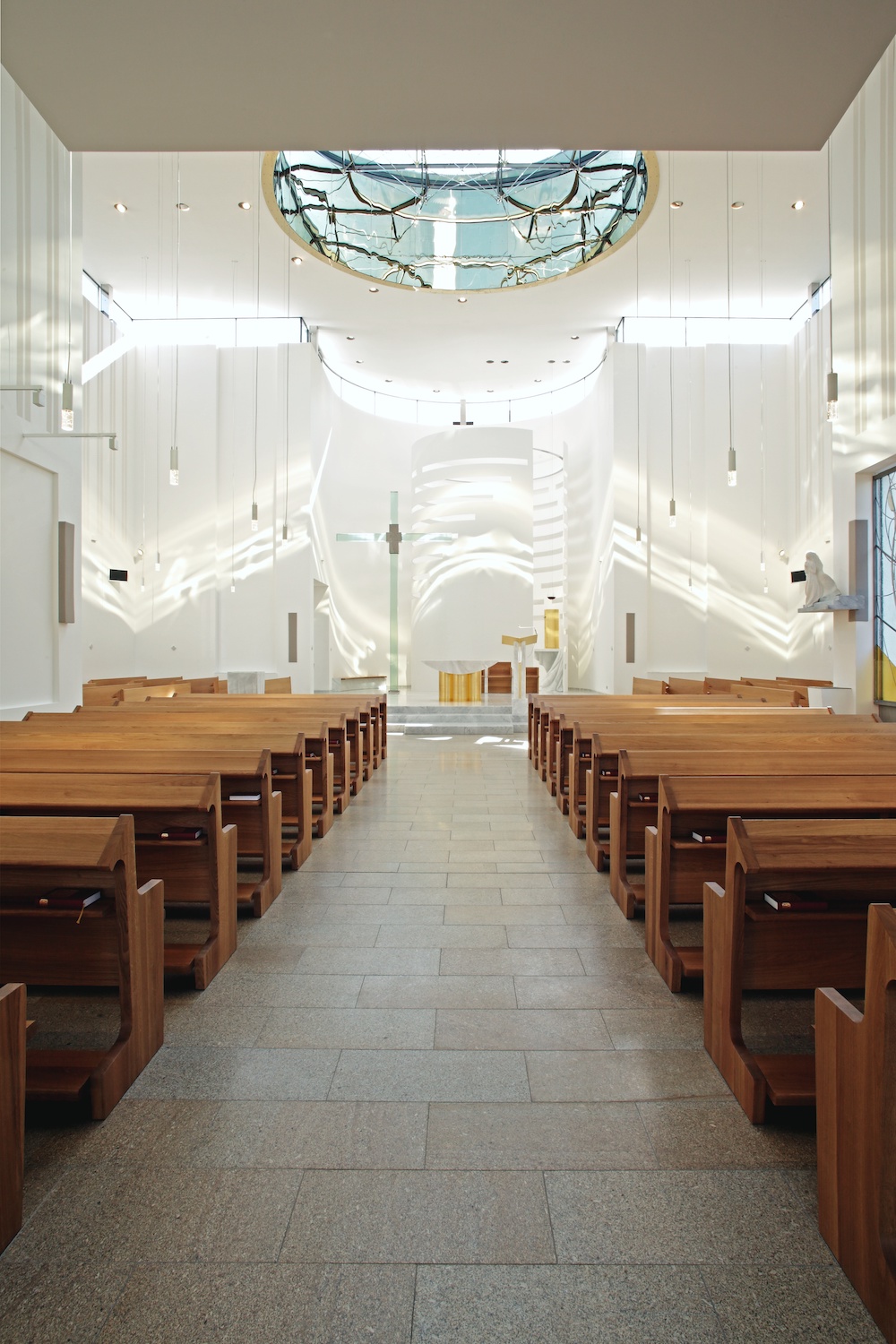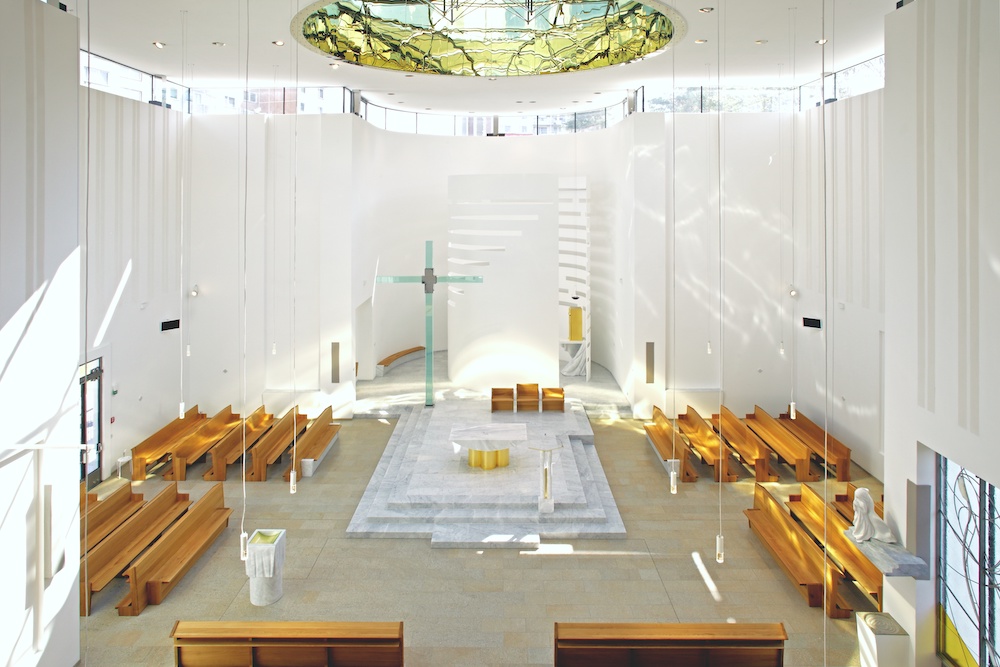Golden light ring
The golden light ring, light crown – a demanding technical and artistic element with the symbolism of the Crown of Thorns dominating the interior of the building, which gives it an unusual light atmosphere that varies depending on the path of the sun across the sky. As the sun rises, it creates gradually diminishing golden reflections on the walls to form a circle around the presbytery at midday and then fades upwards again during the afternoon; in the transitional period, at the end of the day, the sun illuminates the presbytery with the altar through the glass doors of the entrance portal.
Golden light ring
The golden light ring, light crown – a demanding technical and artistic element with the symbolism of the Crown of Thorns dominating the interior of the building, which gives it an unusual light atmosphere that varies depending on the path of the sun across the sky. As the sun rises, it creates gradually diminishing golden reflections on the walls to form a circle around the presbytery at midday and then fades upwards again during the afternoon; in the transitional period, at the end of the day, the sun illuminates the presbytery with the altar through the glass doors of the entrance portal.
For the design and structural solution it was important to determine the boundary temperature and humidity conditions and to determine the effect of reflected solar radiation from the cladding of the tube, whose shape also causes a concentration of reflected energy. It was therefore necessary to use gold sheet cladding above the glazing plane in a ground version, to install automatically opening ventilators in the tube walls to ventilate the space under the glazing in summer and to use glazing units with heating to eliminate condensation on the internal surface when external temperatures drop and humidity rises in the interior when fully occupied; the heating also allows snow removal to be accelerated if necessary. To further reduce solar gain in summer, it was necessary to apply a coating to the glazing units – hence their slightly blue colour.

The main grid of the glazing support structure is made of 70x50mm solid stainless steel profiles on which low aluminium profiles of the ALUPROF system are screwed over a separating washer, with seals to accommodate the glazing units and with internal drainage of condensate from the glazing grooves; behind the gold cladding, the condensate is then drained through a perimeter trough. To prevent deflection of the structure, the main grid is supplemented by cross-guided hangers on 2/3 of the span with pulls made of 5×20 mm polished stainless steel strips and hinged struts in black metallic colour. The whole structure is mounted on elastomeric bearings pads due to the high thermal expansion at the given span and changes in operating temperatures, this is also reflected in the design of the perimeter connection joints. In order for the structure to function properly, it was also necessary to activate the rods to the prescribed values after fitting, which was a complex task due to the spatial action of the entire system.
The gold cladding is implemented on a stainless steel grid anchored to the supporting reinforced concrete structure of the tube. The tiling is supported by elastic bands and anchored by bolted joints with elastic washers to prevent the gold tiling from vibrating – rattling during organ production. For this reason, and because of the temperature range, it was not possible to use concealed fixing of the tiling cassettes.
Designed by Ing. Arch. Jakub Žiška
Contractor/Project Manager: Miroslav Koch – JOFO, s.r.o.
Design solution / project: Ing. Arch. Jakub Žiška – ATELIER Žiška, s.r.o.
Structural engineering: Ing. Milan Novotný
Structural analysis of glazing units: Ing. Miroslav Špaček, Ing. Jiří Veselý – Habena spol. s r.o.
Construction physics – determination of temperature and humidity limit values: Ing. Robert Kůta
Construction physics – assessment of the effect of focusing of reflected solar radiation: Ing. Jiří Čáp, Ph.D.
Technical design of heated glazing units and control system: Jan Horyna, Ing. Zdeněk Císař -Thermoglass.eu s.r.o.
Composition of coatings and technical parameters of glass: Ing. Lucie Chladná – AGC Flat Glass Czech a.s.
Design of elastomer bearings: Josef Kotšmíd – SVP mosty, s.r.o.
Technical design of cemented and connecting joints: Stanislav Jirák – Tremco illbruck s.r.o.
Ing. Jan Klečka – Metrostav a.s.
Activation and strain gauging of the rods: Ing. Dalibor Gregor, Ph.D. – EXCON a.s.


